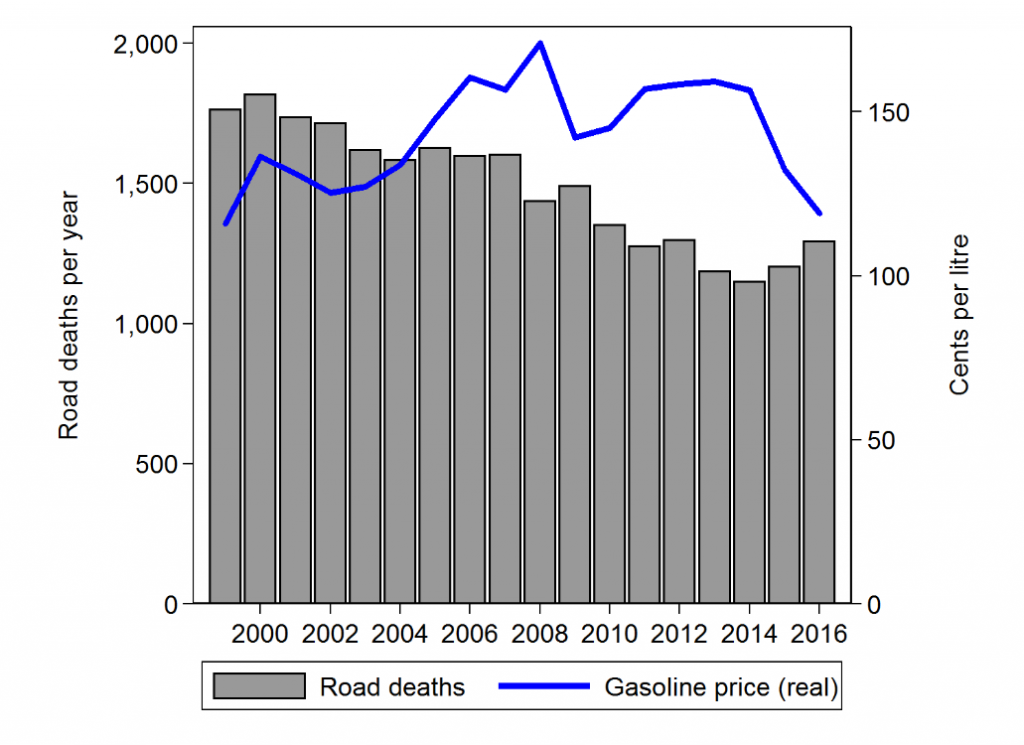After years of progress in improving road safety, Australia’s annual road death toll rose in both 2015 and 2016, reaching 1,293.
In a new article in Economic Papers, Ataklti Teame and I examine the influence of various macro-level variables on road deaths trends in Australia. Our findings indicate that the collapse in the world oil price from late 2014 was a key factor in explaining the increase in Australia’s road deaths.
Australia has a target of reducing road deaths by at least 30% by 2020, relative to the 2008–2010 average. Cheap petrol has contributed to pushing Australia off track from this target.
In response to the increase in road deaths, the Australian government launched an Inquiry into the National Road Safety Strategy 2011–2020.
Petrol prices and road deaths in Australia
The Figure below shows Australia’s annual road deaths and the average real petrol price for the period 2007–2016. A large decline in pump prices in 2015 and 2016 can be seen. Petrol even dropped below $1 per litre at some service stations.
Road deaths and the average real petrol price in Australia

Low petrol prices are good news in many ways. Consumers can afford to drive more, while also having more to spend on other goods and services, or to save.
When it comes to road safety, however, low petrol prices are not such a good story. Cross-country studies and studies from the United States suggest that an increase in road deaths should be expected.
As seen in the Figure, this is indeed what has occurred. Upticks in road deaths were also recorded in a number of other developed economies such as New Zealand, the United States, and Great Britain. These increases worked against long-term downward trends.
Our estimates
Using data for the period 1989–2017, we estimate that each 1% reduction in petrol prices typically leads to around 0.2% more road deaths in the short run, holding other factors constant. This implies that the decline in fuel prices in 2015 and 2016 made a sizeable contribution to the increase in Australia’s road death toll.
Part of the story is that low petrol prices encourage people to drive. Road deaths per vehicle-kilometre travelled also increased.
We also found evidence that the decline in Australia’s unemployment rate was an additional source of upward pressure on Australia’s road deaths. Our study does not rule out other potential contributors – such as changes in patterns of drug use.
That low petrol prices tend to lead to more road deaths was not unknown to police. Our research provides the first quantification of the effect in the Australian context.
Over the longer run, the effect of fuel prices on road deaths is likely to be larger than the short-run effects estimated in this research.
Implications
One implication of our study is that it makes sense to ramp up road safety campaigns when petrol prices are low.
Another is that an increase in the rate of fuel excise would place downward pressure on Australia’s road death toll. Australia has one of the lowest fuel excise rates in the OECD.
The future on our roads
The road sector is set to undergo a transformation over coming decades, with vehicles on track to become increasingly electric and autonomous. Autonomous vehicles may well play a key role in improving road safety.
The switch to electric vehicles means that fuel excise is set to diminish in importance as a government revenue source.
An attractive reform option would be to adopt a system of road-use pricing as a replacement for fuel excise. Vehicles would be charged a higher road-use price on congested roads to help to alleviate congestion. Higher prices could also be charged for larger vehicles that are more dangerous to the community, such as SUVs.
The good news is that Australia’s road death toll fell by 5% in 2017 relative to 2016. Despite this progress, road deaths remained 7% above the 2014 level, and 23% above the 2020 target. Any large reduction in fuel costs would make the 2020 target even more challenging to reach.
An open access version of the research paper is available here. This research formed a submission to the Inquiry into the National Road Safety Strategy 2011–2020.





Total serious injuries continued to increase, so real road trauma, ie Killed and seriously injured did not decline at all. Occupant protection and collision avoidance technologies in new cars, those that do the most mileage continued to improve. There are many more factors which impact on road trauma than average petrol prices. Current fuel tax, heavy vehicle charging, tolls and to some extent land rates are are road pricing. Simply adding to the tax burden will not guarantee fewer deaths.
Hi Lauchlan,
There are issues with the injury data, but they indicate that total serious injuries declined in the 1980s and early 1990s, before starting to increase again (http://www.cycle-helmets.com/1925-05-casualties.pdf; https://bitre.gov.au/publications/ongoing/hospitalised-injury.aspx).
Our study focuses on road deaths because of their importance and also due to superior data quality and availability for this variable.
Road trauma is a function of many factors, as you say. This is reflected in the discussion throughout the paper. The goal of the paper is to statistically test the effect of macro-level variables on the underlying risk of road fatalities.
Land rates do not seem to be closely related to the topic. The discussion is not about increasing the tax burden (tax/GDP). It is about using economic instruments to help to improve road safety. There is a literature on this that you might be interested in, for example: http://www.vtpi.org/price_safe.pdf
All the best,
Paul